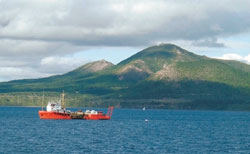Netherlands: One-stop approach expedites survey offshore Sakhalin Island
Apr. 2002 Vol. 223 No. 4 European Technology Round Up
A major, multi-disciplinary integrated survey in support of the Sakhalin II Project has been completed by the Dutch-based Fugro group of companies. Sakhalin II is operated by the Sakhalin Energy Investment Co. (SEIC) consortium (Shell, 62.5%; Mitsui, 25%; and Mitsubishi, 12.5%). SEIC is developing Piltun-Astokhskoye and Lunskoye oil and gas fields on the northeastern coast of Sakhalin Island (far eastern Russia) by adding two gravity base production platforms (GBPs) to the existing Moliqpak GBP. These platforms will be linked to a processing and export plant in the southern portion of the island, at Aniva Bay. Pipelines will be installed to shore and overland to Aniva Bay. SEIC awarded Fugro a contract for near-shore and offshore geophysical surveys and geotechnical investigations, with Shell acting on behalf of SEIC for the project design. The geophysical work included a pipeline survey, site survey and sand search. These involved about 2,100 line km (1,305 mi) offshore and 160 line km (99 mi) near-shore of sub-bottom profiler (mini-airgun, boomer and pinger), multi-beam echo sounder, single-beam echo sounder, magnetometer and sidescan sonar; 40 vibrocores and 60 mini-cone tests (Seascout) and grab samples. The offshore geophysical work was completed in 31 days by the survey vessel Volans, which went on to do the seabed sampling. The near-shore survey was undertaken by the local, shallow-draft survey vessel, Misa. A number of offshore tide gauges were installed.
Geotechnical investigations for platform sites took 43 days, using the m/v Mariner. They included soil sampling and cone penetrometer tests, "piggy back" rock coring and a shallow gas pilot hole. Working off Sakhalin presents a number of challenges. It is remote and inhospitable (it is only possible to undertake surveys for three months of the year), and there are no ports in the northern region, while those in the south have very basic facilities. There are long waits to obtain permits for temporary import of vessels and equipment, and there are limited flights. Meeting these challenges required a high degree of planning, especially due to the multidisciplinary nature of the work that involved seven Fugro companies from Canada, Holland, Singapore and the UK. "It was important that there was a single, focal point for the client," said a Fugro spokesman. "With this one-stop shop approach, conflicts due to differences in interest and competitive considerations do not occur. The advantages of this approach were clearly demonstrated during the Sakhalin project." |
|||||||||||||
- Quantum computing and subsurface prediction (January 2024)
- Mixed outlook for activity on the UK Continental Shelf (December 2023)
- Machine learning-assisted induced seismicity characterization of the Ellenburger formation, Midland basin (August 2023)
- What's new in exploration (March 2023)
- Seismic and its contribution to the energy transition (January 2023)
- First Oil: Sorting through the muddled mess (November 2022)
- Applying ultra-deep LWD resistivity technology successfully in a SAGD operation (May 2019)
- Adoption of wireless intelligent completions advances (May 2019)
- Majors double down as takeaway crunch eases (April 2019)
- What’s new in well logging and formation evaluation (April 2019)
- Qualification of a 20,000-psi subsea BOP: A collaborative approach (February 2019)
- ConocoPhillips’ Greg Leveille sees rapid trajectory of technical advancement continuing (February 2019)




